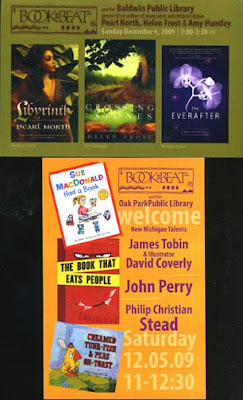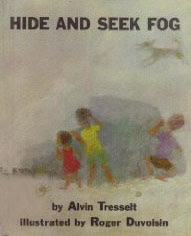This Sunday’s Brunch is a day late.
Don’t worry, I’m not going to make a habit of it. The holidays, while wonderful, have caused some disruptions in my normal routine. Things should return to normal as soon as the Christmas tree comes down.
...Unfortunately, last year I didn’t take the tree down until well after Martin Luther King Day.
But in 2010 I vow to do better. How’s that for a New Year’s Resolution?
In the spirit of the New Year, today’s brief blog looks back at the most representational children’s books of this past decade and looks ahead to a book from the next decade.
THIS WORLD WE LIVE IN
You know you patronize a cool bookstore when the owner calls you on Christmas morning to say that she just got an ARC (advance reading copy) of a new book that you’ll want to read. The ARC in question was THIS WORLD WE LIVE IN by Susan Beth Pfeffer, the third volume in the post-apocalyptic series that began with LIFE AS WE KNEW IT and continued with THE DEAD & THE GONE. Saturday afternoon I rushed over to the bookstore to pick it up and then spent Sunday reading it. Can you imagine a more cheery Christmas read than a novel of isolation, deprivation, euthanasia, and imminent death and destruction?
Susan Beth Pfeffer began her writing career just out of college with the publication of JUST MORGAN. Since then she’s written dozens of children’s and young adult novels, including such memorable titles as ABOUT DAVID and THE YEAR WITHOUT MICHAEL. In 2006 she published her best-known work, LIFE AS WE KNEW IT, which describes how a meteor strike throws the moon out of orbit, drastically affecting life on Earth. The story is related by Miranda Evans, a teenager from Pennsylvania, who records how the lunar catastrophe leads to starvation, mayhem, and the deaths of friends and neighbors. It’s a science fiction book for readers who don’t generally like science fiction -- a speculative novel that deals with the human side of a worldwide crisis. A sequel, THE DEAD & THE GONE (2008) told the story of the same event from the perspective of New York teenager Alex Morales.
THIS WORLD WE LIVE IN (to be published in April) is again told through Miranda’s diary entries. If LIFE AS WE KNEW IT was a tale of loss and letting go (not just the the loss of food, sunlight, and modern conveniences, but also friends who do not survive the crisis), THIS WORLD WE LIVE IN is a story of gaining new family members and friends, and opening oneself to experiences such as traveling (even a ninety-mile journey is an adventure) and falling in love.

It’s been nearly a year since the moon fell out of orbit and Miranda, her brothers, and their mother, are still cold and starving. Things start to look up when Miranda begins breaking into abandoned houses for food and supplies and her brothers travel to fish from the Delaware River. Soon her older brother marries a girl he barely knows and Miranda’s father, new wife, and their baby arrive with a group of travelers...including Alex Morales and his younger sister Julie. It was perhaps inevitable that Miranda and Alex would meet in Pfeffer’s series and their subsequent hasty romance at times feels more prescribed by plot than truly felt by the characters. Nevertheless the book is a page-turner, and the author does a great job showing how some aspects of daily, domestic life are retained while others are lost forever in the face of encroaching horror. In the final pages, a tornado -- almost a deus ex machina in reverse -- brings further destruction and causes Miranda to make some shattering decisions that will forever change her life. Although she ends the novel saying that she will no longer write in her diary, the story practically demands a sequel (readers will want to know more about the rumored “safe towns” located around the country...and there needs to be a follow-up to the tantalizing hints that Miranda’s new sister-in-law has given about her past.) Anyone who reads THIS WORLD WE LIVE IN will anxiously await the next installment in this fascinating series.
A DECADE ENDS
Seems like it was only a couple years ago that we were stockpiling water and batteries for Y2K. Now the decade is about to end. This got me wondering about titles best represent the past ten years. It’s not necessarily a list of good books -- in fact, a couple of the titles below stink to high heaven -- but just a roster representing the state of children’s publishing from 2000 to 2009.
2000 / HARRY POTTER AND THE GOBLET OF FIRE by J.K. Rowling
Not the first HP book, but the first from this millennium, and it helped set the tone for the era. Suddenly children’s books were cool for adults and crowds would turn out for midnight release parties. If only more children’s books got this kind of reception!
2001 / READING MASTERY II : STORYBOOK I by Siegfried Engelmann and Elaine C. Bruner
Why would a book in a thirty-one volume reading text best represent 2001? Because one of the stories in this book, “The Pet Goat" was being read by the president while planes crashed into the World Trade Center. “The Pet Goat” immediately became one of the most well-known titles in children’s literature (though most people called it “My Pet Goat” for some reason) yet it remains a story that almost nobody has read.
2002 / HOOT by Carl Hiassen
After about twenty years of celebrities and “adult writers” trying to write children’s books and producing the literary equivalent of plant fertilizer, Carl Hiassen attempted a kids’ book and scored both a popular and critical (Newbery Honor) triumph. It’s probably the high-point of the “celebrity author trend.”
2003 / ERAGON by Christopher Paolini
Personally I couldn’t read it, but ERAGON deserves recognition for representing the trend of self-published books that ended up getting attention from big mainstream publishers with deep pocket$.
2004 / THE O’REILLY FACTOR FOR KIDS by Bill O’Reilly
Every day millions of children turn off their iPods, power down their computers, and put down their Playstation joysticks to gather around the TV to watch Bill O’Reilly on Fox TV. They don’t? Then how to explain the huge sales figures for this advice volume from a TV blowhard and falafel fan? Obviously it was this decade’s “Most Purchased Book by Parents and Grandparents.”
2005 / TWILIGHT by Stephenie Meyer
The reason why every other young adult title now must contain one of the following words: neck, blood, vamp, undead, bite, or suck.
2006 / THE END by Lemony Snicket
The end of an era. When I read THE BAD BEGINNING, the first volume in this series, I thought it was mildly-amusing, but didn’t have a lot of appeal for kids. Seven years, thirteen volumes, and fifty-five million copies later, Lemony Snicket proved me wrong.
2007 / THE INVENTION OF HUGO CABRET by Brian Selznick
Winning the Caldecott Medal proved that the graphic novel for children had really come of age.
2008 / THE GRAVEYARD BOOK by Neil Gaiman
Similarly, many cheered when this novel won the Newbery Medal, marking one of the rare times when a book both critically acclaimed and kid-friendly had won the big N.
2009 / ???
What book do you think best represents the state of children’s publishing for 2009? Which titles above would you bump in order to include other books better representing this past decade?
Thanks for visiting Collecting Children’s Books. Hope you’ll be back!








































